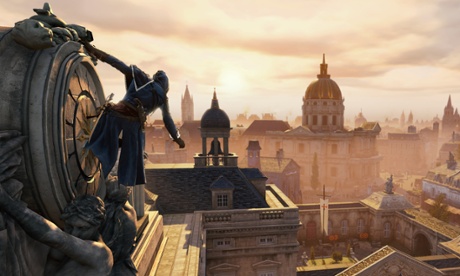
Here’s a prediction for you: the next Assassin’s Creed title – and by that we mean the one after Assassin’s Creed Unity – will be an online persistent world. That’s because, in both its size and its ambition, Unity seems only one step away from the genre that looks set to define games in the coming generation; the genre that already counts Destiny, The Crew and The Division among its numbers.
Set in the largest world ever created for this series, Unity is bursting at the seams with features that seem to lend themselves more to an MMO than to a predominantly single-player format. And by now every fan of this series knows that up to four players can join up and play the campaign missions co-operatively.
But there is something else that hints toward a more complex future for the series: the addition of a feature the developers are calling AMM (Adapted Mission Mechanic). This aspect, the developers say, ensures that every player’s in-game experience will be unique. Their progression in the game is affected not just by the weapons they collect and the skills they unlock, but in the moments they pick to interact with targets and NPCs in their environment. AMM gives the missions in Unity a more dynamic feel than in previous games and events feel less rigidly scripted.
For example, one mission, which involved shadowing and killing an aristocrat in Notre Dame, had several points in which the player’s progression could be affected. If they swooped in early on their target they’d miss out on conversation snippets revealing more of the plot. Furthermore, both the access to the cathedral and the means they use to kill the target, depend entirely on the skills they’ve acquired so far – lockpicking, for example. The method of dispatch may also be rewarded with a rather gruesome cinematic – slicing through the victim’s throat in a confessional, for instance. If the player loses the target, the mission won’t de-synch as it did in previous games; there is a set amount of time to reacquire the quarry before the mission is failed.
Loose thrills, varied kills
The Assassination missions have also taken on a looser, more open-ended structure. They’re much more similar to the kill-boxes offered in games like Hitman: Blood Money, where players have myriad approaches and tactics available to them. There’s no one way to successfully complete a mission, meaning players can revisit them again and again.
While co-op is a big new feature in Assassin’s Creed: Unity, players are able to tackle all of the missions alone. However, the developers say that because some missions have been designed with more than one player in mind, lone wolves may find themselves in for a tough challenge. Still, that shouldn’t deter any truly committed assassins.
Assassin’s Creed: Unity is also a far darker game than its predecessors. Pre-Revolution Paris looks and feels like a city on the edge. Fights between rival factions break out on street corners; crowds of braying civilians surround the city guards who have no compunction in cutting them down with gunfire. The environment is a powder keg and it only needs a spark to explode. It also looks absolutely stunning – which shouldn’t come as much of a surprise since the visuals in the Assassin’s Creed game have always been impeccable.
Freedom and control
The design team has given players the smoothest, most streamlined control layout the series has seen for a while, making it much easier to explore those densely crowded rooftops. Good thing too; not only is Unity’s Paris a multi-tiered metropolis where players can seamlessly transition inside and outside buildings and explore every inch from the rooftops to the catacombs, but the scale of the map is 1:1 with its real world counterpart.
Holding down the right trigger and pressing A will send the player scrambling up walls, while pressing B will change their direction. There’s less of a danger here in tapping the wrong button and sending your assassin crashing to the cobbles. The Y button activates Eagle Vision, tagging NPCs and enemies in the player’s environment, while the D-pad brings up the vast assortment of weapons the player is bound to collect.
There’s now a dedicated stealth button – the left trigger sends the protagonist into a crouch and muffles their footsteps – and players should prepare themselves for quite a bit of sneaking about. Stealth gameplay dovetails rather nicely with the gothic atmosphere in Unity; it’s hard not to feel like the Dark Knight when your cowled avatar is crouched on the buttresses of Notre Dame staring grimly at their target as rain hammers down and lightning crashes in the sky above.
The second reason for the emphasis on stealth ties into the new combat system. In previous Assassin’s Creed games, players were able to slash their way through dozens of enemies by spamming one defensive move. In Unity, the enemy AI monitors the player’s style of combat and if it spots them using one attack to attempt to win every fight, it switches up its approach accordingly.
Furthermore, a lot of the enemies player will encounter are far tougher and better armed than their assassin, and if they’re surrounded, the player’s best option is to flee.
In spite of the greater sense of peril, Assassin’s Creed: Unity feels like the most intuitive gateway into the series for newbies. The city of Paris is easy to navigate, swoon-worthy in appearance and alive with missions, quests and activities for players to get stuck into. It may not be a persistent world quite yet, but it looks guaranteed to take weeks of your life nonetheless.
Assassin’s Creed Unity is due out on 28 October for PC, PS4 and Xbox One
- Assassin’s Creed Unity – the most gruesome game trailer ever?
- From Watch Dogs to GTA V, why ‘video games are going to reshape our cities’

